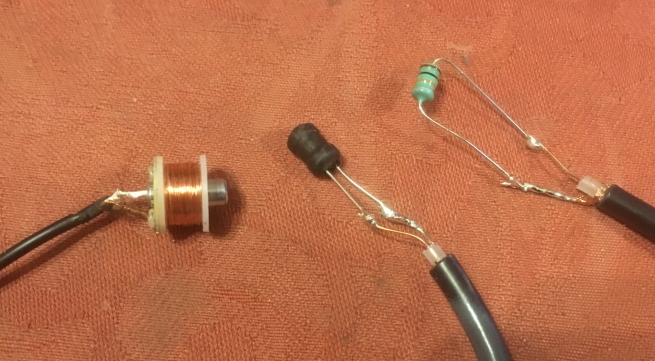After looking into piezo elements and electret microphones, I decided to try another kind of pickup described by Nic Collins, the magnetic inductor.
Collins describes using a device marketed as a telephone pickup coil – I don’t know what the situation is now, but it used to be illegal to attach recording devices directly to the telephone network, so a telephone pickup coil has a suction cup on one end to stick to the telephone handset, and a 3.5mm mono plug on the other end to connect to an amplifier or recording device.
I bought a few of these for about £1.50 each from CPC.
I wanted to see what was inside, so I sawed the top off one of them and took out the contents of the plastic enclosure.
It appeared to be a simple inductor coil, rather like a small guitar pickup, but with no indication of its value.
Inductors are the the third ‘passive linear circuit elements that make up electronic circuits,’ (https://en.wikipedia.org/wiki/Inductor) along with resistors and capacitors. Their values are expressed in Henries (H), although 1 Henry is quite a large value and the the majority of inductors encountered in circuits fall in the millihenry (mH) range.
I was expecting to find other components inside the telephone coil enclosure, having read here: http://hydrophones.blogspot.co.uk/2010/09/induction-coil-pick-up-now-available.html that ‘whilst most other coils on the open market have certain limitations placed upon them, these adapted coils [for sale on that site] can detect a wider range of sounds that the technology is capable of . . . adapting the coils not only increases the range of frequencies but also boosts the overall signal level.’ There was no further information about the nature of the limiting circuitry, or the means of boosting the signal level, but perhaps the coils I bought were not the type with limitations, I couldn’t tell.
Nor could I tell what value of inductor could perform the function of the telephone coil. An article here: http://www.unterzuber.com/tap.html on how to make a telephone coil recommends 100 turns of 28AWG wire on ferric core; another here: http://www.circuitstoday.com/telephone-pickup-preampliifer (sic) recommends 3000 – 5000 turns of 0.4mm on a plastic former.
There is a company called Knowles, which manufactures ‘telecoils’: inductors which can be built into hearing aids to amplify sounds created by an induction loop (http://www.knowles.com/eng/Products/Hearing-aid-components-accessories/Telecoils). However, these are rare and quite expensive (£2 – £7 each from a component supplier with a minimum order requirement and delivery cost – more than the Telephone Pickup itself). The values of these covered a very wide range, from about 30mH to over 900mH.
So, in order to experiment, I first had the coil from the Telephone Pickup. I also bought some smaller inexpensive inductors of different values. These were (on the left) 100mH, costing a little under 40p each, and (on the right), different values between 1mH and 10mH, costing a little under 4p each.
I also had a guitar pickup, which works on exactly the same principle, as mentioned above, but has 6 separate magnetic poles within it. This was about £2:
*
The preamp I had used recently for the electret micophones seemed to work fine, so I used this and experimented with the various different inductors, passing them over my laptop keyboard, a good source of magnetic noise.
These were the 3 inductors I compared: the Telephone Pickup Coil is on the left, the 100mH in the middle, and the 10mH on the right.
This is what they sounded like, running over the same small area of the laptop keyboard (the most interesting section!):
It seemed to me that the Telephone Pickup Coil was the most sensitive; the 100mH a little less sensitive, but still effective – perhaps more effective in some areas where there was a great deal of noise; and the 10mH was a little too insensitive. On balance, I thought the Telephone Coil was probably the one to use in a best quality application, but the 100mH would be fine in cases where cost was a major factor.
*
For the next round of experiments I made some stereo inductor pickups: in one case I took the coil out of a second Telephone Pickup and hot glued a pair of them to a shaped piece of scrap acrylic; in the other I mounted two 100mH inductors side by side to a smaller acrylic strip. I also tried out the standard-sized guitar pickup.
These three pickups were a great improvement on the single inductor pickups, and sounded like this, with the guitar first, then the stereo Telephone Coils, then the stereo 100mH inductors:
I had to be careful with the guitar pickup, as bringing it near the laptop seemed to cause strange effects – the screen going blank, for example, which was not good . . . However, this wouldn’t be a danger in the application I hand in mind for it.
In fact, I would recommend NOT experimenting with a guitar pickup like this. Because of the magnets in it, it could possibly damage sensitive circuits like laptops, mobile phones, etc. – stick to the passive inductors, like the other ones I used.
In the next post in this series, I will describe an instrument I made based on inductor pickups.







Awesome, just the info I was looking for. I see the telephone inductors on amazon for $6-10 USD and then the classic inductors are $8 for a bag of 20. I am curious how a 1000iu and 10000iu inductor would compare to the telephone pickup though.
My interest is using the inductor as a magnetic pulser using square waves from a signal generator for current instead of as a microphone but still all info I was wondering about. Thank you for writing the blog.
Many laptops have a magnetic switch that detects when the lid is closed and turns off the screen. That might be why bringing the guitar pickup coil near the laptop caused the screen to turn off.